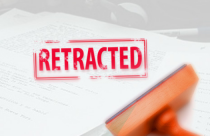Fake Research Papers Published and Retracted

What would you make of a paper entitled “Rooter: A Methodology for the Typical Unification of Access Points and Redundancy.” How about “On the Emulation of Expert Systems Based on Development of Agents.” Or “R2D: A Bridge between the Semantic Web and Relational Visualization Tools.” I have no idea what these papers are about. For two of them, neither does anyone else. They are fake research papers, completely meaningless, created by the writing version of a random number generator. Yet they were accepted for publication by supposedly reputable journals.
How to Write Nonsense
Writing a fake scientific paper is easy. Just log onto the MIT web page pdos.csail.mit.edu/scigen, enter some fake authors’ names, and hit “generate.” I tried it out and a nanosecond later had a paper entitled “Decoupling Replication from DNS in the Transistor,” by Drs. Abdulla Goldmann and Seymore Butz. This was a full paper, complete with Abstract, Table of Contents, graphs, and twelve references. The content was meaningless to me, but so are most papers concerning computer science at a theoretical level. If I were given a paper like this to review, I would have glanced at the first page and handed it to someone else to deal with. But a number of journals don’t go this far. There motto seems to be, When in Doubt, Publish.
How to Publish Nonsense
The MIT graduate students who devised SCIgen were probably just having fun but some of them put the nonsense generator to good use, sending fake papers to real journals and eventually exposing themselves as hoaxers. A pioneer was Cyril Labbé who published a fake paper by fictitious author Ike Antkare, and then gamed the Google Scholar system to make Antkare the 21st most cited author on this system, easily bumping Albert Einstein, who came in a mere 36th. Labbé has documented more than 120 gibberish papers published between 2005 and 2013, in peer-reviewed journals and conferences.
How to Spot Gibberish
It’s easy to spot nonsensical papers if you know what to look for, even easier if you use an automated program that cranks through articles like a spell checker, flagging suspicious phrases. No doubt journals will start to do this, eliminating the potential embarrassment of publishing a senseless paper. But the problem of poor reviewing of manuscripts will remain.
The Real McCoy
Which of the three papers cited was real? Find out by logging onto the link below. The answer is at the end.
http://www.thewire.com/technology/2014/03/more-computer-generated-nonsense-papers-pulled-science-journals/358735/
http://www.nature.com/news/publishers-withdraw-more-than-120-gibberish-papers-1.14763










This topic was at the top of my mind while writing a post about possible NFT use cases on publish0x. I think it’s important to make academic research publicly available and comprehendible lol. It’s easy to pass off nonsense when it takes advantage of what is essentially purple prose to confuse and frustrate the reader.
Maybe having submissions include a plain language summary along with the academic paper would make it easier for editors reviewing content for journals would make this process easier?